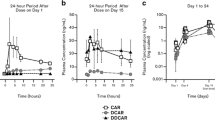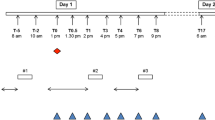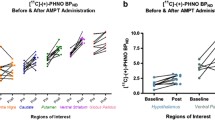Abstract
Using positron emission tomography and the selective ligands 11C-SCH23390 and 11C-raclopride, central D1- and D2-dopamine receptor occupancy was determined in schizophrenic patients treated with clinical doses of classical and atypical neuroleptics. Treatment with ten chemically distinct classical neuroleptics resulted in a 65–89% occupancy of D2-dopamine receptors. This finding represents strong support for the hypothesis that the mechanism of action of antipsychotic drugs is indeed related to a substantial degree of D2-dopamine receptor occupancy. In two patients treated with teh atypical neuroleptic clozapine, 300 mg b.i.d. and 150 mg b.i.d., the D2-dopamine receptor occupancy was 65 and 40%, respectively. D1-dopamine receptor occupancy was determined in six antipsychotic drugtreated patients. No D1-dopamine receptor occupancy was found in patients treated with sulpiride and perphenazine, compounds known to be selective D2-dopamine receptor antagonists. The highest D1-dopamine receptor occupancy, 42%, was found in the patient treated with clozapine 150 mg b.i.d. The effects of the atypical neuroleptic clozapine may be related to a combined effect on both D1- and D2-dopamine receptors.
Similar content being viewed by others
References
Andersson PH, Nielsen EB, Groenvald FC, Braestrup C (1986) Some atypical neuroleptics inhibit 3H-SCH23390 binding in vivo. Eur J Pharmacol 120:143–144
Barnes TRE, Braude WM (1985) Akathisia variants and tardive dyskinesia. Arch Gen Psychiatry 42:874–878
Carlsson A (1978) Antipsychotic drugs, neurotransmitters, and schizophrenia. Am J Psychiatry 135:164–173
Creese I, Burt DR, Snyder SH (1976) Dopamine receptor binding clinical and pharmacological potencies of antischizophrenic drugs. Science 192:481–483
Farde L, Hall H, Ehrin E, Sedvall G (1986) Quantitative analysis of dopamine-D2 receptor binding in the living human brain by positron emission tomography. Science 231:258–261
Farde L, Wiesel F-A, Hall H, Halldin C, Stone-Elander S, Sedvall G (1987a) D2-receptor increase in PET-study of schizophrenia. Arch Gen Psychiatry 41:671–672
Farde L, Halldin C, Stone-Elander S, Sedvall G (1987b) PET-analysis of human dopamine receptor subtypes using 11C-SCH23390 and 11C-raclopride. Psychopharmacology 92:278–284
Farde L, Wiesel F-A, Halldin C, Sedvall G (1988a) Central D2-dopamine receptor occupancy in schizophrenic patients treated with antipsychotic drugs. Arch Gen Psychiatry 45:71–76
Farde L, Pauli S, Hall H, Eriksson L, Halldin C, Högberg T, Nilsson L, Sjögren I, Stone-Elander S (1988b) Stereoselective binding of 11C-raclopride in living human brain — a search for extrastriatal central D2-dopamine receptors by PET. Psychopharmacology 94:471–478
Farde L, Wiesel FA, Jansson P, Uppfeldt G, Wahlen A, Sedvall G (1988c) An open label trial of raclopride in acute schizophrenia. Confirmation of D2-dopamine receptor occupancy by PET. Psychopharmacology 94:1–7
Halldin C, Stone-Elander S, Farde L, Ehrin E, Fasth K-J, Långtröm B, Sedvall G (1986) Preparation of 11C-labelled SCH23390 for the in vivo study of dopamine D1 receptors using positron emission tomography. Int J Appl Radiat Isot 37:1039–1043
Hyttel J (1983) SCH23990—the first selective dopamine D1 antagonist. Eur J Pharmacol 91:153–154
Iorio LC (1981) SCH23990. A benzazepine with atypical effects on dopaminergic systems. Pharmacologist 23:136
Kebabian JW, Calne DB (1979) Multiple receptor mechanisms for dopamine. Nature 277:93–96
Köhler C, Hall H, Ögren S-O, Gawell L (1985) Specific in vitro and in vivo binding of 3H-Raclopride. A potent substituted benzamide drug with high affinity for dopamine D2 receptors in the rat brain. Biochem Pharmacol 34:2251–2259
Overall JE, Gorman DR (1962) The brief psychiatric rating scale. Psychol Rep 10:799–812
Peroutka SJ, Snyder SH (1980) Relationship of neuroleptic drug effects at brain dopamine, serotonin, adrenergic and histamine receptors to clinical potency. Am J Psychiatry 137:1518–1522
Sedvall G, Farde L, Persson A, Wiesel FA (1986) Imaging of neurotransmitter receptors in the living human brain. Arch Gen Psychiatry 43:995–1005
Seeman P, Lee T, Chau-Wong M, Wong K (1976) Antipsychotic drug doses and neuroleptic/dopamine receptors. Nature 261:717–719
Stille G, Hippius H (1971) Kritische Stellungsnahme zum Begriff der Neuroleptika (anhand von pharmakologischen und klinischen Befunden mit Clozapin). Pharmacopsychiatry 4:182–191
Wagner HN, Burns HD, Dannals RF, Wong DF, Långström B, Duelfer T, Frost JJ, Raert HT, Links JM, Rosenblom SB, Lukas SE, Kramer AV, Kuhar MJ (1983) Imaging dopamine receptors in the human brain by positron tomography. Science 221:1264–1266
Author information
Authors and Affiliations
Rights and permissions
About this article
Cite this article
Farde, L., Wiesel, F.A., Nordström, A.L. et al. D1- and D2-dopamine receptor occupancy during treatment with conventional and atypical neuroleptics. Psychopharmacology 99 (Suppl 1), S28–S31 (1989). https://doi.org/10.1007/BF00442555
Issue Date:
DOI: https://doi.org/10.1007/BF00442555




